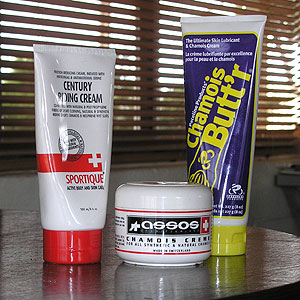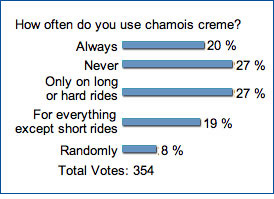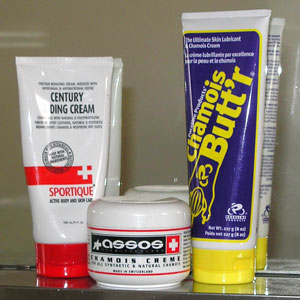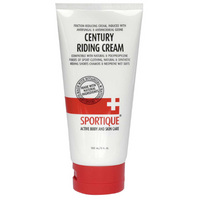Chamois cream: the best thing you’re not using

Keep your ear close to the tracks if you're in the business of selling goods and services to triathletes. If you do, your company will talk to you. One message you'll get, loud and clear, is that triathletes need comfort while aboard their tri bikes. This isn't an oh-by-the-way message. It's a "we-need-comfort-now!" message.
Unfortunately, a lot of those in the business aren't listening to what their companies are telling them. But your comfort is not simply their responsibility, but your own as well. To that end, you may have noted what we wrote last month, the link to which is at the bottom of this page, and it referred to the differences between position problems, point tenderness, and friction. These are the three causes of discomfort while riding. Friction, that's one that's been overlooked. To that end, the issue of chamois cream was broached.
We wrote about chamois cream, but not in detail. Here's the detail. In anticipation of writing this we conducted a pair of polls, and we asked our readers what their incidence of use is, and what it is they preferred.
We were not surprised to learn that more than a quarter of you don't use chamois cream at all, ever, during your riding. That's okay, if you don't chafe and if you don't experience hot spots "down there" while you're riding, and if you consider yourself comfortable in the area of the saddle. But we know that for most of you who aren't chamois cream users, that's not the way you'd characterize your level of comfort.

How do you know if friction is the source of your problem? If it's a position problem, you're not going to feel it in your crotch, rather in your low back, or shoulders, or some other place. But not down there. If you feel it there, it's either a point tenderness problem—in which case you need to replace equipment, like your saddle or your shorts—or the issue is friction. It's point tenderness if the problem is immediate. It's friction if the problem develops over a few miles.
Now that you are sensitized to the concept of chamois cream, how do you use it? To me, it's a mischaracterization to call it chamois cream because its primary job is not to condition your chamois. Rather, it's to reduce friction, and secondarily to stave off fungal and bacterial infections down there. Yes, you're told by the manufacturers to put chamois cream on your chamois, either before you ride or after you wash your shorts, or both. But mainly, your chamois cream is for you, not for your clothing. You put it on you. And, not sparingly. You don't put a little on and rub it in, as you might sunblock. You grab a gob, and rub it wherever it is you'll contact the saddle, for triathletes primarily in between your thighs.
One more thing about its use as a chamois conditioner. Notwithstanding the directions on the tubes and tubs telling you to put chamois cream on your chamois, that's applicable in the old days when your shorts really did have a chamois. Almost certainly, your shorts you're now wearing don't have a pad made of a chamois. So, that bit of advice on your chamois cream's container is best ignored.
Unless I'm taking a bike out for a test ride of a very few—as in fewer than five—miles just to see if a bike's adjusted right, then I'm going to slather on chamois cream. The longer the ride, the more you need to put on there, because chamois cream shares common ingredients with moisturizing lotions, and these molecules penetrate the skin. As they are absorbed, just like a skin lotion, the friction reducing capabilities lessen. So, on long rides, I extra-protect.
I also race with chamois cream, and this is when I'll use the most. This is because the chamois cream goes on before the gun goes off, which means I'm swimming with it. Some or most of its ingredients are water soluble, so you'll exit the water with a little less than you entered it with. Therefore, lube up.

When we polled our readers, what we found is this: only 1-in-3 of you really liked your bicycle saddle. Another third of you said it's "good enough." The balance of you said you hated your saddle, or that it's good enough but you "could be much happier." Maybe that's your saddle's fault, but before I took the step of getting a new saddle I'd see if perhaps the issue was friction. Even if your saddle is correct for you, and your shorts are fine, there's the issue of you rubbing on you. There's lots of skin down there. So, why not try chamois cream first?
That narrows us to brand. Me, I'm a big believer in products that are purpose-specific. If I want to protect myself from the rays Martians are beaming at me, I'm not going to fashion a tin-foil hat. There are anti-Martian-ray hats manufactured for the purpose (or if there aren't there ought to be). While A+D Ointment is great for your infant, and Noxzema is a great skin moisturizer, neither is specifically made to be a chamois cream. This should narrow down the list for you a bit more.
I've got three different chamois creams in my bathroom cabinet, because I like to change things up a bit. My three faves are Assos, Chamois Butt'r and Century Riding Cream. Those first two suck up about half the market. Let's talk about Assos first.
This is great stuff. It's not cheap, at $20 or so per tub for just under 5 fluid ounces. It's notable feature is the party in your pants once you slather it on, and that comes from menthol and witch hazel. Once I was all set, chamois creamed and all, to go on a ride and then found out I was time-limited. So I pulled off the cycling shorts, put on some Jammer-style swim shorts and went for a plunge. Whoopee! Once water hits that area it's like Icy-Hot, without the Hot. Forewarned, if you use Assos in a triathlon, be prepared for a little jolt once water gets into your wetsuit. It's not painful, just alerting.

Chamois Butt'r is the American-made analog to Assos, at least in terms of sales. Slowtwitch readers who use chamois cream are equally split in their preferences, with a quarter choosing Assos and a quarter Chamois Butt'r. Some would use Chamois Butt'r but for its lack of whoopee. So, Chamois Butt'r now makes a version with witch hazel and menthol, so if that's what you want, now you can have it all.
You may wonder whether women find the Assos whoopee irritating. I polled women on our Slowtwitch women's forum and asked them this. By about 4-to-1 women who've used Assos prefer iit, and most specifically like the menthol. But, some do not.
Assos comes in a tub, Chamois Butt'r in a tube. Do you want the tub? Okay, but Assos is the only one I know of that presents chamois cream in this delivery system. The tubs turn out to be quite expensive, so if you want Chamois Butt'r in a tub you'd have to pay more for it. Advantage to the tub: you can scrape the insides to get every last little bit. Disadvantage to the tub: your greasy, sleazy friends are going to stick their fingers in your tub, and if they didn't get enough after the first dip, in go those fingers for the second dip.
I was turned on to a small Czech company called Sportique and these folks make a lot of different creams and ointments, all for athletes. They are sticklers for natural ingredients, bio-oils versus mineral oils, no parabens, stuff like that. This is a very classy company, with limited U.S. Distribution. I have several of their products and like them all, and their chamois cream is first rate. But, I'm more likely to use Assos or Chamois Butt'r if I'm riding more than 60 miles, because Sportique's Century Riding Cream seems, with its predisposition toward using natural skin conditioning ingredients, to absorb a little faster.
Century Riding Cream joins Beljum Budder in eschewing parabens. There is an internet-driven urban myth of a linkage between parabens and breast cancer, but everything I've read on this points to a lack of causality between parabens and cancer. Keep in mind that parabens are not rare in cosmetics and lotions, they are a staple. Just the same, if parabens are not for you, then it's these two products you should be looking at.



